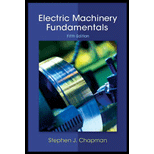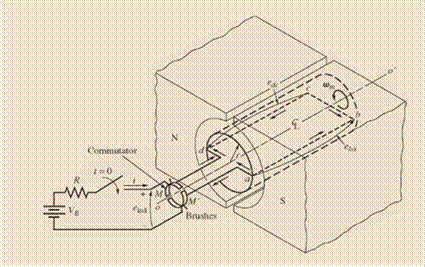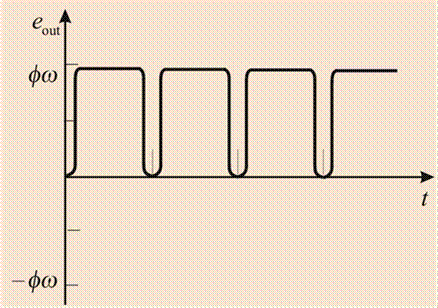
Concept explainers
What is commutation? How can a commutator convert ac voltages on a machine’s armature to dc voltages at its terminals?
To define: The term commutation.
To describe: The process of conversion of ac voltage on the machine’s armature to the dc voltage at the terminals by the commutator.
Explanation of Solution
Commutation is defined as the process of the reversal of the loop connections on the rotor of the DC machine when the polarity is reversed in the loops. The reversal of the loop connection on the rotor if the voltage polarity in the loops reversed is important in order to maintain the output voltage as the pure DC voltage.
The process of the conversion of the AC voltage into the DC by the commutator is described below:

Consider the simple two pole two conductor DC machine as shown above.
Here two conducting segments which are similar added at the end of each conductor. The voltage generated in the machine is collected from the two similar conductors by the help of the two fixed contacts. Here, the fixed contacts are arranged in a way that the conducting segment are shorted at the instant when the voltage induced in the loops is zero.
So, each time the voltage in the loop change their polarity, the conducting segment which are connecting to the fix contacts will change when the conducting segment are revolving with the conductor. The conducting segments are known as the commutator segment. The process of the change of the connection at commutator end is known as the brushes.
The output wave of the DC machine is shown below:

Want to see more full solutions like this?
Chapter 7 Solutions
Electric machinery fundamentals
- Solve on paper not using chatgptarrow_forwardAssume that a building manager instructed you to install a water heater. The specs on the water heater nameplate reveals the following 240V, 2PH, 60HZ, 5.7KW. The manager insisted for the installation to be done with 10 AWG copper THWN-2 conductor, the length of run is 1200 FT away from the service panel. Calculate the voltage after the installation.arrow_forwardPlease confirm that my solution is correct, especially the block diagram. Please DRAW (not type) what the block diagram would look like if it's incorrect. thank youarrow_forward
 Introductory Circuit Analysis (13th Edition)Electrical EngineeringISBN:9780133923605Author:Robert L. BoylestadPublisher:PEARSON
Introductory Circuit Analysis (13th Edition)Electrical EngineeringISBN:9780133923605Author:Robert L. BoylestadPublisher:PEARSON Delmar's Standard Textbook Of ElectricityElectrical EngineeringISBN:9781337900348Author:Stephen L. HermanPublisher:Cengage Learning
Delmar's Standard Textbook Of ElectricityElectrical EngineeringISBN:9781337900348Author:Stephen L. HermanPublisher:Cengage Learning Programmable Logic ControllersElectrical EngineeringISBN:9780073373843Author:Frank D. PetruzellaPublisher:McGraw-Hill Education
Programmable Logic ControllersElectrical EngineeringISBN:9780073373843Author:Frank D. PetruzellaPublisher:McGraw-Hill Education Fundamentals of Electric CircuitsElectrical EngineeringISBN:9780078028229Author:Charles K Alexander, Matthew SadikuPublisher:McGraw-Hill Education
Fundamentals of Electric CircuitsElectrical EngineeringISBN:9780078028229Author:Charles K Alexander, Matthew SadikuPublisher:McGraw-Hill Education Electric Circuits. (11th Edition)Electrical EngineeringISBN:9780134746968Author:James W. Nilsson, Susan RiedelPublisher:PEARSON
Electric Circuits. (11th Edition)Electrical EngineeringISBN:9780134746968Author:James W. Nilsson, Susan RiedelPublisher:PEARSON Engineering ElectromagneticsElectrical EngineeringISBN:9780078028151Author:Hayt, William H. (william Hart), Jr, BUCK, John A.Publisher:Mcgraw-hill Education,
Engineering ElectromagneticsElectrical EngineeringISBN:9780078028151Author:Hayt, William H. (william Hart), Jr, BUCK, John A.Publisher:Mcgraw-hill Education,





